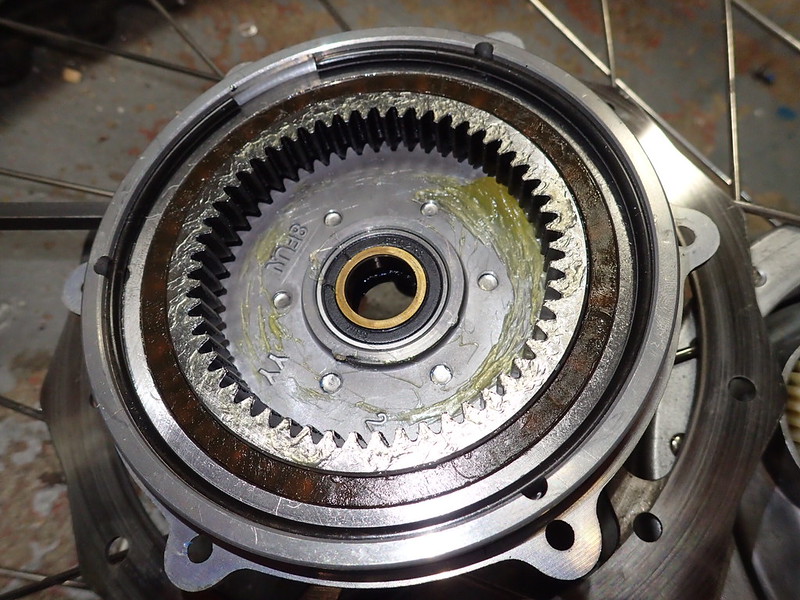Alex W
10 W
(I had incorrectly posted this in the wrong forum, I'm moving it over here. Sorry if you've seen it twice)
This is the hub used by the Faraday. I'm using one on my bike and selected it over other options due to the light weight (2kg vs 2.6kg or more for other Bafang alternatives) and the good disk mount (Cute has theirs 2mm out of spec, which won't work with my fork).
I cracked my hub open today to see how the internals compare to other Bafang/8Fun hubs and was surprised to see a double reduction planetary system. The clutch is also in a different place, it is mounted between the ring gear and the outside of the hub shell. This also means that the torque is transferred from the ring gear to the hub flanges through 6 M5 bolts (the ring gear is in the hub's "cap"). That is probably fine since 6 bolts of the same size also transfer all of the disk stopping power.
This photo is of the hub cap (where the disk is mounted) and ring gear:

This is the double reduction system. Note that the motor and larger gears are helical cut:

I'm curious if there might be higher RPM motors or gear sets available for this hub to increase the hub's maximum speed in a 700C wheel from 22mph (20mph realistically) to something higher. The native hub RPM is 250 (measured), 270rpm (spec) at 42 volts.
It is good to see that the hub has handled ~1000 miles, lots of it in the rain and mounted on bus racks, without any water intrusion. That was one of my concerns.
This is the hub used by the Faraday. I'm using one on my bike and selected it over other options due to the light weight (2kg vs 2.6kg or more for other Bafang alternatives) and the good disk mount (Cute has theirs 2mm out of spec, which won't work with my fork).
I cracked my hub open today to see how the internals compare to other Bafang/8Fun hubs and was surprised to see a double reduction planetary system. The clutch is also in a different place, it is mounted between the ring gear and the outside of the hub shell. This also means that the torque is transferred from the ring gear to the hub flanges through 6 M5 bolts (the ring gear is in the hub's "cap"). That is probably fine since 6 bolts of the same size also transfer all of the disk stopping power.
This photo is of the hub cap (where the disk is mounted) and ring gear:

This is the double reduction system. Note that the motor and larger gears are helical cut:

I'm curious if there might be higher RPM motors or gear sets available for this hub to increase the hub's maximum speed in a 700C wheel from 22mph (20mph realistically) to something higher. The native hub RPM is 250 (measured), 270rpm (spec) at 42 volts.
It is good to see that the hub has handled ~1000 miles, lots of it in the rain and mounted on bus racks, without any water intrusion. That was one of my concerns.

